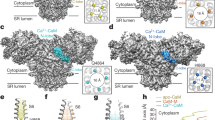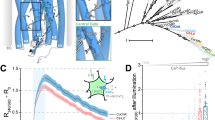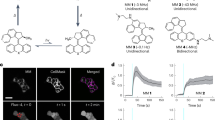Abstract
THE entry of calcium ions into cells through voltage-activated Ca2+ channels in the plasma membrane triggers many important cellular processes. The activity of these channels is regulated by several hormones and neuretransmitters, as well as intracellular messengers such as Ca2+ itself (for examples, see refs 1–9). In cardiac muscle, myoplasmic Ca2+ has been proposed to potentiate Ca2+ influx1,7–9, although a direct effect of Ca2+ on these channels has not yet been demonstrated. Photosensitive 'caged-Ca2+ molecules such as nitr-5, however, provide powerful tools for investigating possible regulatory roles of Ca2+ on the functioning of Ca2+ channels10,11. Because its affinity for Ca2+ is reduced by irradiation, nitr-5 can be loaded into cells and induced to release Ca2+ with a flash of light10. By using this technique we found that the elevation of intracellular Ca2+ concentration directly augmented Ca2+-channel currents in isolated cardiac muscle cells from both frog and guinea pig. The time course of the current potentiation was similar to that seen with β-adrenergic stimulation. Thus Ca2+ may work through a similar pathway, involving phosphorylation of a regulatory Ca2+-channel protein. This mechanism is probably important for the accumulation of Ca2+ and the amplification of the contractile response in cardiac muscle, and may have a role in other excitable cells.
This is a preview of subscription content, access via your institution
Access options
Subscribe to this journal
Receive 51 print issues and online access
$199.00 per year
only $3.90 per issue
Buy this article
- Purchase on Springer Link
- Instant access to full article PDF
Prices may be subject to local taxes which are calculated during checkout
Similar content being viewed by others
References
Marban, E. & Tsien, R. W. J. Physiol., Lond. 329, 589–614 (1982).
Mentrard, D., Vassort, G. & Fischmeister, R. J. gen. Physiol. 83, 105–131 (1984).
Campbell, D. L., Giles, W. R., Hume, J. R. & Shibata, E. F. J. Physiol., Lond. 403, 287–315 (1988).
Kass, R. S. & Sanguinetti, M. C. J. gen. Physiol. 84, 705–726 (1984).
Lee, K. S., Marban, E. & Tsien, R. W. J. Physiol., Lond. 364, 395–411 (1985).
Bechem, M. & Pott, L. Pflügers Arch. ges Physiol. 404, 10–20 (1985).
Fedida, D., Noble, D. & Spindler, A. J. J. Physiol., Lond. 405, 461–475 (1988).
Noble, S. & Shimoni, Y. J. Physiol., Lond. 310, 57–75 (1981).
Tseng, G-N. Circulation Res. 63, 468–482, (1988).
Gurney, A. M., Tsien, R. Y. & Lester, H. A. Proc. natn. Acad. Sci. U.S.A. 84, 3496–3500 (1987).
Adams, S. R., Kao, J. P. Y., Grynkiewicz, G., Minta, A. & Tsien, R. Y. J. Am. chem. Soc. 110, 3212–3220 (1988).
Page, S. & Niedergerke, R. J. cell. Sci. 11, 199–203 (1972).
Tsien, R. Y. Biochemistry 19, 2396–2404 (1980).
Vaughan-Jones, R. D., Lederer, W. J. & Eisner, D. A. Nature 301, 522–524 (1983).
Kaibara, M. & Kameyama, M. J. Physiol., Lond. 403, 621–640 (1988).
Richard, S., Nerbonne, J. M., Nargeot, J., Lester, H. A. & Garnier, D. Pflügers Arch. ges. Physiol. 403, 312–317 (1985).
Bonvallet, R. Pflügers Arch. ges. Physiol. 408, 540–542 (1987).
Mitra, R. & Morad, M. Proc. natn. Acad. Sci. U.S.A. 83, 5340–5344 (1986).
Reuter, H. Nature 301, 569–574 (1983).
Lamers, J. M. J. Gen. Physiol. Biophys. 4, 143–154 (1985).
Charnet, P. thesis, Univ. Tours (1988).
Kameyama, M., Hofmann, F. & Trautwein, W. Pflügers Arch. ges. Physiol. 405, 285–293 (1985).
Lee, K. S. Proc. natn. Acad. Sci. U.S.A. 84, 3941–3945 (1987).
Fedida, D., Noble, D. & Spindler, A. J. J. Physiol. Lond. 405, 439–460 (1988).
Niedergerke, R. J. Physiol., Lond 134, 569–583 (1956).
Fabiato, A. Am. J. Physiol. 245, C1–C14 (1983).
Armstrong, D. et al. J. gen. Physiol. 92, 10a (1988).
Hume, J. R. & Giles, W. J. gen. Physiol. 78, 18–43 (1981).
Lee, K. S. & Tsien, R. W. J. Physiol., Lond. 354, 253–272 (1984).
Author information
Authors and Affiliations
Rights and permissions
About this article
Cite this article
Gurney, A., Charnet, P., Pye, J. et al. Augmentation of cardiac calcium current by flash photolysis of intracellular caged-Ca2+ molecules. Nature 341, 65–68 (1989). https://doi.org/10.1038/341065a0
Received:
Accepted:
Issue Date:
DOI: https://doi.org/10.1038/341065a0
This article is cited by
-
Pacing lightly: optogenetics gets to the heart
Nature Methods (2010)
-
Calmodulin supports both inactivation and facilitation of L-type calcium channels
Nature (1999)
-
Bradykinin B2‐receptor‐mediated modulation of membrane currents in guinea‐pig cardiomyocytes
British Journal of Pharmacology (1998)
-
Regulation of Ca channel by intracellular Ca2+ and Mg2+ in frog ventricular cells
Pflügers Archiv European Journal of Physiology (1996)
-
Measurement of intracellular Ca2+ concentration using Indo-1 during simultaneous flash photolysis to release Ca2+ from DM-nitrophen
Pfl�gers Archiv European Journal of Physiology (1994)
Comments
By submitting a comment you agree to abide by our Terms and Community Guidelines. If you find something abusive or that does not comply with our terms or guidelines please flag it as inappropriate.



